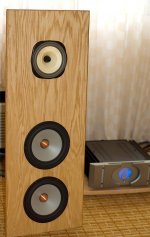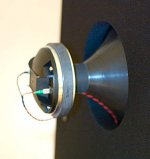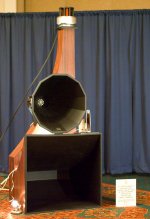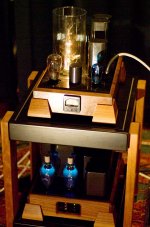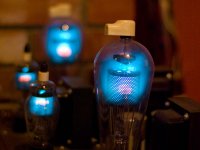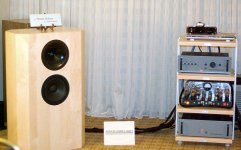Back of Emerald Physics OB Speaker. Not much to photograph since all of the front is covered in stretchy grill cloth except for the waveguide - and it's black too. They use stretchy grill cloth on the rear too, giving an interesting effect stretched over the two magnets of the 15" bass drivers.
Attachments
The power supply for Steve K's 75TL amplifier - he's one of the other Colorado hifi fans that built this transmitter-tube DHT amplifier. You can see why I'd rather photograph amplifiers instead of boring old loudspeakers.
Oh yes, it sounds good - very very good. I was listening to Steve's system on Tuesday, and it sounded better than anything at the show. Top quality throughout, and wonderful sound.
Oh yes, it sounds good - very very good. I was listening to Steve's system on Tuesday, and it sounded better than anything at the show. Top quality throughout, and wonderful sound.
Attachments
John Atwood, co-founder of Vacuum Tube Valley magazine and blogmaster of the ClariSonus blog. Worth a visit, by the way - lots of good photos of John's recent trip to Thailand and Vietnam.
Attachments
Lynn Olson said:Alexander of RAAL, coming all the way over from Serbia to visit us here in the States.
We get him next.
The AudioKinesis system, with front and rear-facing 11" TAD drivers, and front and rear-facing waveguides with Beyma CP380 compression drivers. The rear-facing HF driver has its own independent crossover (not shared with the front driver) - the rear crossover uses a highpass filter contour designed to minimize radiation from the rear diffracting around to the front.
In all the uproar about the Feastrex, I personally think the AudioKinesis is a better choice for those of us who like full-scale symphonic, choral, and rock music. Much more headroom, and superb tonal balance - a rarity at this year's show.
In all the uproar about the Feastrex, I personally think the AudioKinesis is a better choice for those of us who like full-scale symphonic, choral, and rock music. Much more headroom, and superb tonal balance - a rarity at this year's show.
Attachments
Not intending to spam, but Lukas from AudioJunkies.com has tons of pictures up on the website.
www.AudioJunkies.com
www.AudioJunkies.com
Lynn,
Wow, thanks for the positive comments! I'll get that kick-back check out to you right away!! ;o)
Who knows what I told you about my speakers at the show, but this is what I should have said:
The waveguide-controlled radiation pattern is what prevents the rear HF driver's output from diffracting around the cabinet. Both woofers' outputs will diffract around the cabinet baffle-step-style, such that the rear woofer starts assisting where the front woofer starts falling off; elimination of the baffle-step is one advantage of a bipole. However there is a tradeoff: Centered on the frequency where the wrap-around path is equal to one-half wavelength there will be a dip as the wraparound energy arrives at the listening position out-of-phase with the front woofer. This dip can be moved around and mitigated by cabinet geometry, which is what I've done. The dip disappears in the power response and in practice is of little or no audible significance, but it would show up in a quasi-anechoic measurement and make the speaker bad on paper.
Also, the compression driver I use is the Beyma CP385/Nd. I think I told you wrong at the show. I do modify it a little bit.
Very nice photo, by the way. Thanks for posting it!
Duke
Wow, thanks for the positive comments! I'll get that kick-back check out to you right away!! ;o)
Who knows what I told you about my speakers at the show, but this is what I should have said:
The waveguide-controlled radiation pattern is what prevents the rear HF driver's output from diffracting around the cabinet. Both woofers' outputs will diffract around the cabinet baffle-step-style, such that the rear woofer starts assisting where the front woofer starts falling off; elimination of the baffle-step is one advantage of a bipole. However there is a tradeoff: Centered on the frequency where the wrap-around path is equal to one-half wavelength there will be a dip as the wraparound energy arrives at the listening position out-of-phase with the front woofer. This dip can be moved around and mitigated by cabinet geometry, which is what I've done. The dip disappears in the power response and in practice is of little or no audible significance, but it would show up in a quasi-anechoic measurement and make the speaker bad on paper.
Also, the compression driver I use is the Beyma CP385/Nd. I think I told you wrong at the show. I do modify it a little bit.
Very nice photo, by the way. Thanks for posting it!
Duke
Lynn Olson said:
First Watt (Nelson Pass design) OB Lowther. Bi-amplified with a 75 Hz active crossover between the 10" Scan-Speak woofers and the PM6A Lowther.
You probably mean Seas W26FX001 instead of Scanspeak
Thanks for the link. Lots of eye candy, but some captions would have helped. Very, very little of it looked that interesting unfortunately.DevilDriver said:Not intending to spam, but Lukas from AudioJunkies.com has tons of pictures up on the website.
www.AudioJunkies.com
Hmm - the Cogents. My impression is "a work in progress". The suave, understated quality of the field-coil compression drivers is the most noticeable hallmark of the speaker. The Ionovac supertweeter wasn't audible at all - I think the efficiency was something like 10~15 dB lower than the mid/high horn.
The overall sound quality was very different than an old-school Altec or JBL theatre system, much more laid-back and subtle. Of all the horns systems I've heard so far, the AudioKinesis and Steve K's and John P's AER/Azurahorns are closest to my own preferences
I'm no horn expert, as many (including Romy) have already reminded me, but the profiles I saw at the show aren't my favorites. I still don't see how a conical horn is any different in coloration than a megaphone - they sure look the same to me. The bass horn has a number of sharp bends and profile changes, especially compared to the smooth continuous curves of Bill Fitzmaurice's prosound bass horns.
I'd be very curious how the Cogents would sound with a LeCleac'h profile mid/high horn, like the Azurahorn AH-204, a Bill Fitzmaurice continuous-curve bass horn, and an ultra-efficient RAAL "water drop" supertweeter at the top. I'm sure it would measure a lot smoother, and the virtues of the field-coil drivers would probably be more evident.
But I'm not a horn guy. The colorations of most horns bother me - a lot, more than I can accept. The horn fans actively enjoy that sound, so I'm not well-placed to critique horns one way or another. If I got my mitts on one, I'd spend a lot of time and trouble trying to remove the horn sound, while keeping the dynamics - the LeCleac'h Azurahorn route, most likely. From the perspective of a traditional horn enthusiast, I'd probably ruin it in the process.
The overall sound quality was very different than an old-school Altec or JBL theatre system, much more laid-back and subtle. Of all the horns systems I've heard so far, the AudioKinesis and Steve K's and John P's AER/Azurahorns are closest to my own preferences
I'm no horn expert, as many (including Romy) have already reminded me, but the profiles I saw at the show aren't my favorites. I still don't see how a conical horn is any different in coloration than a megaphone - they sure look the same to me. The bass horn has a number of sharp bends and profile changes, especially compared to the smooth continuous curves of Bill Fitzmaurice's prosound bass horns.
I'd be very curious how the Cogents would sound with a LeCleac'h profile mid/high horn, like the Azurahorn AH-204, a Bill Fitzmaurice continuous-curve bass horn, and an ultra-efficient RAAL "water drop" supertweeter at the top. I'm sure it would measure a lot smoother, and the virtues of the field-coil drivers would probably be more evident.
But I'm not a horn guy. The colorations of most horns bother me - a lot, more than I can accept. The horn fans actively enjoy that sound, so I'm not well-placed to critique horns one way or another. If I got my mitts on one, I'd spend a lot of time and trouble trying to remove the horn sound, while keeping the dynamics - the LeCleac'h Azurahorn route, most likely. From the perspective of a traditional horn enthusiast, I'd probably ruin it in the process.
The Ionovac supertweeter wasn't audible at all - I think the efficiency was something like 10~15 dB lower than the mid/high horn.
I don't know whether or not you noticed, but the Ionovac was being driven by a Dynaco SCA-35 that was hidden from view. The 75TL in the main amp was driven only by an Arcturus type 27 tube. It was amazing that the 3.5 watt 75TL amp was able to fill up that very large room with such good sound.
John
I still don't see how a conical horn is any different in coloration than a megaphone - they sure look the same to me.
Conical horns have intrinsically less distortion than exponential flair types, but they don't load the driver as efficiently. I thought they sounded quite good, but obviously such a system probably won't do orchestral music that well.
John
- Status
- This old topic is closed. If you want to reopen this topic, contact a moderator using the "Report Post" button.
- Home
- Loudspeakers
- Multi-Way
- RMAF2007 Photos
